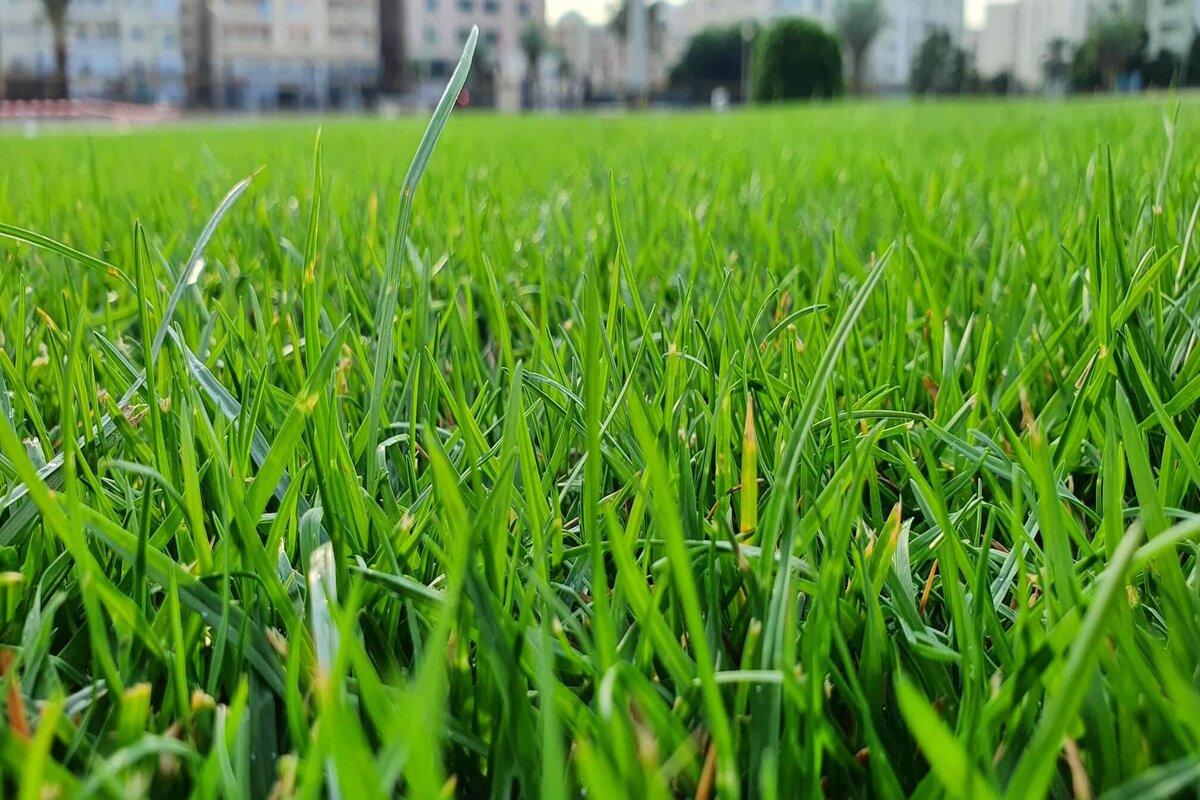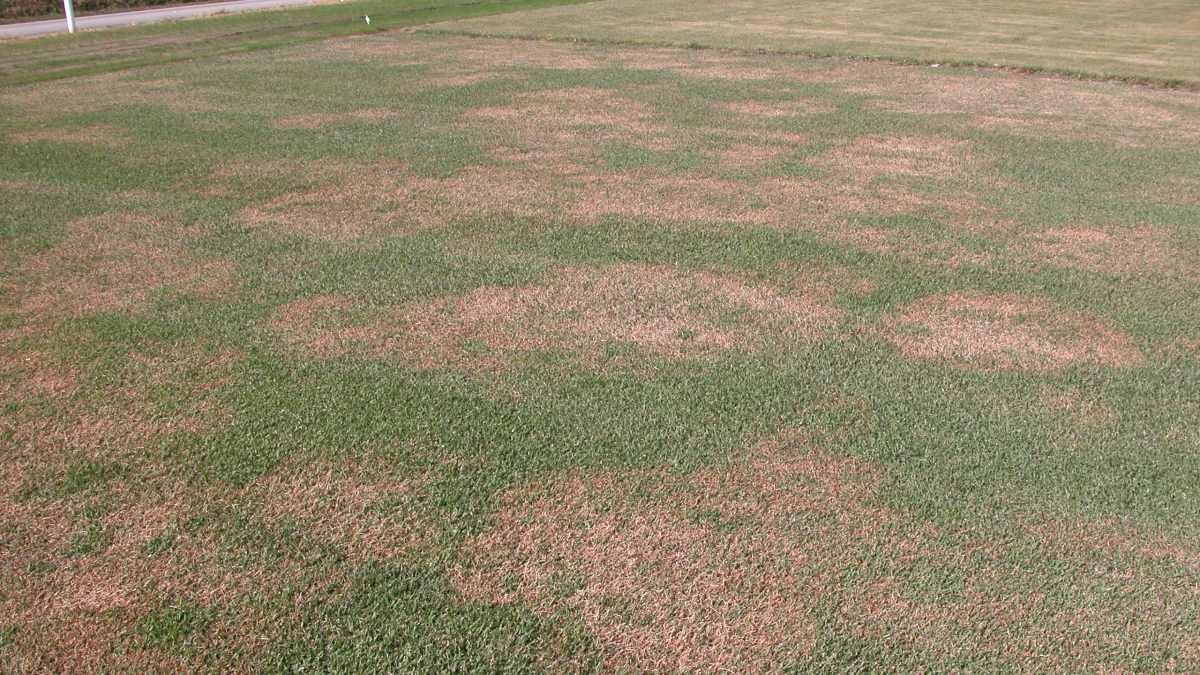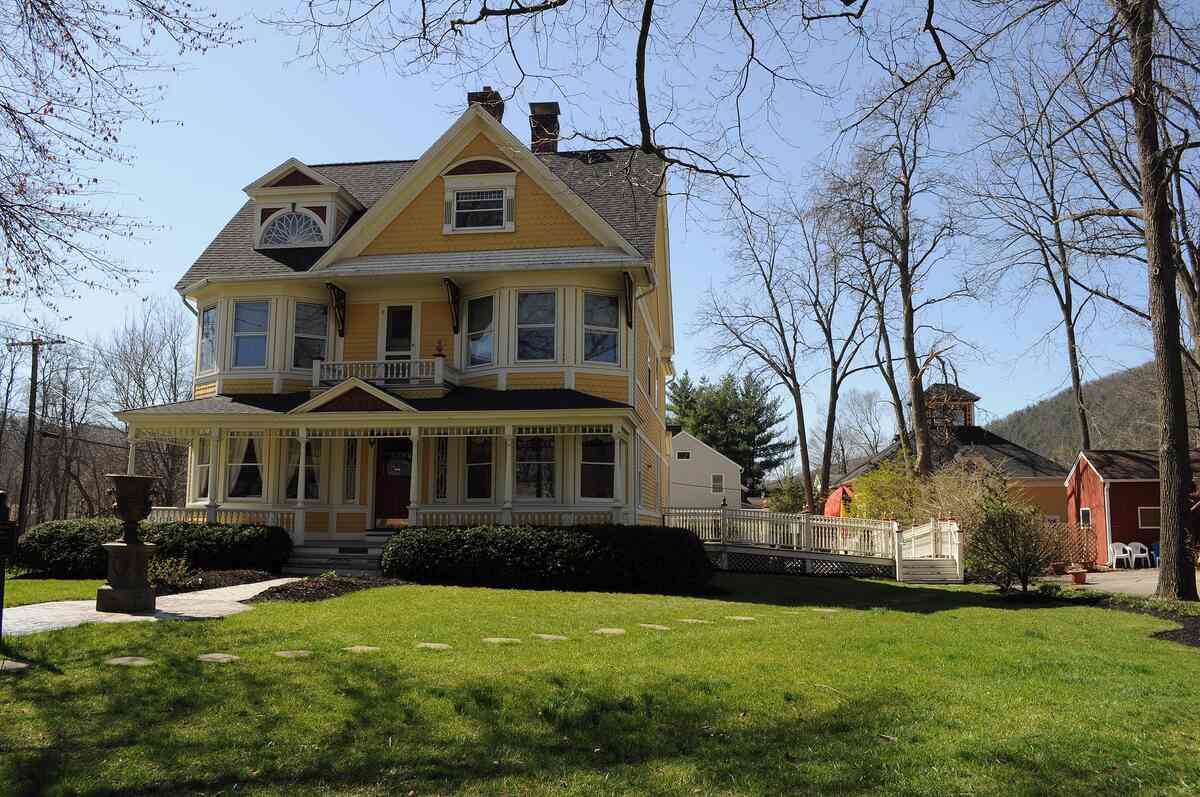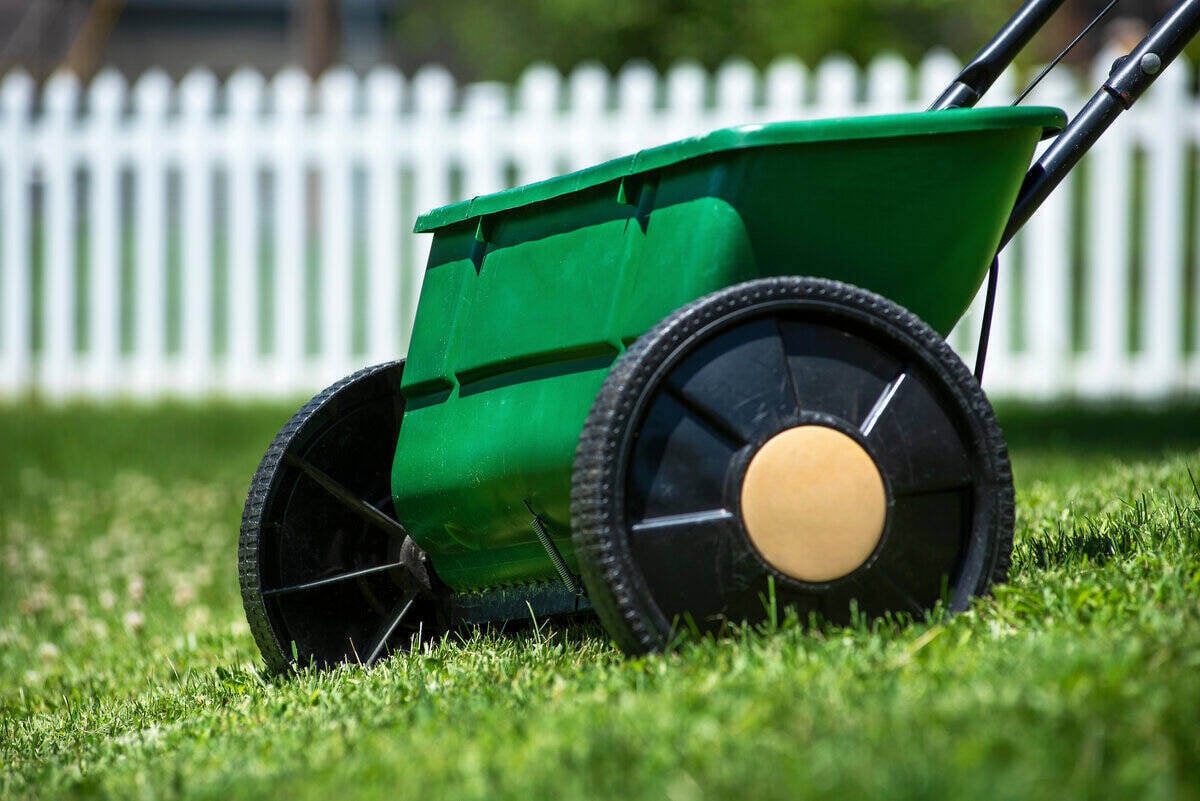
Overseeding gives your lawn a huge boost. If done right, it can make your grass thicker and give you a green lawn through winter. But how do you do it right? Just follow the advice in this complete guide on how to overseed a lawn in eight simple steps.
What is Overseeding?
Overseeding a lawn means spreading new grass seed over an existing lawn to fill in bare patches and make the grass thicker.
Note: Don’t confuse overseeding with reseeding, which is when you pull up the grass and start a whole new lawn from scratch. For more information on reseeding, see our article on How to Plant Grass Seed in 6 Steps.
How to Overseed an Existing Lawn in 8 Steps
To overseed your existing lawn, you’ll have to prepare the soil, spread the seed, and care for the new seedlings. These steps will walk you through exactly how to do it all.
Supplies Needed to Overseed a Lawn
- Lawn mower
- Rake
- Fertilizer spreader
- Grass seed
- Enriched topsoil
- Lawn starter fertilizer
- Dethatcher/power rake/verticutter (optional)
- Core aerator (optional)
Step 1: Dethatch and Aerate the Lawn (If Necessary)
For new grass to grow, the seeds have to be able to reach the soil. Dethatching and aerating your lawn before spreading the seed can help with that. This step isn’t absolutely necessary, but it will lead to more successful seed germination.
First, dethatch the lawn if the layer of thatch in your yard is thick enough that you can’t see the soil through it. After dethatching, aerate the lawn by poking holes in the soil with a core aerator machine. You only need to aerate now if you haven’t done so in the past year.
Step 2: Mow the Lawn Short
On the day you plan to overseed, cut your grass down to an inch or shorter. Shorter grass gives the new seeds better access to the soil underneath. Bag the grass clippings as you mow so they don’t go back into the lawn, where they’ll get in the way of the seeds.
Step 3: Rake to Remove Debris
After mowing, rake your yard to remove any loose grass clippings, fallen leaves, twigs, or other debris that might come between the seeds and the soil. Make sure the rake digs into the ground a bit so it loosens the top layer of soil as you go.
Step 4: Add Enriched Topsoil
Enriched topsoil is a mixture of nutrient-rich compost and soil that will help the new grass grow quicker and thicker. Use a fertilizer spreader to add a layer of the topsoil about 1/4 inch thick on top of your existing grass.
Note: Some grass seed mixtures already include topsoil. If you’re using one of these mixtures, skip this step and go straight to spreading the seed.
Step 5: Spread the Grass Seed
Before choosing a grass seed mixture, know your grass type. Use seeds for either the same type of grass already growing in your yard or a compatible grass type. Usually, “compatible” means cool-season grass types with other cool-season grass types and warm-season grass types with other warm-season grass types.
Fill a fertilizer spreader with your chosen grass seed mixture. Walk the spreader across your lawn in rows, following the same pattern you use when you mow. For information on how much seed to use, see the package label.
Two Types of Push Behind Spreaders
Homeowners can choose two kinds of push spreaders (meaning you walk behind the spreader and push it forward) for their residential lawns: a drop spreader or a broadcast spreader.
When choosing a spreader for overseeding your lawn, it’s important to consider the size and configuration of the area you want to cover. Check out the chart below, which will help you determine which type is best for your lawn:
| Drop Spreader | Broadcast Spreader |
| Smaller lawns that are less than 5,000 square feet | Larger lawns that are 5,000 to 20,000 square feet |
| Tight areas with lots of landscaping, narrow lawn areas, tight turns, planting beds | Wider areas containing “straight runs” without many tight areas and turns |
| Precise work: A drop spreader drops the product directly underneath as you push it, giving you more control over the target area. | Broader work: A broadcast spreader distributes the product in a broad, overlapping pattern, which helps you cover a lot of ground in a relatively short time. |
| Direct soil contact is important. | Direct soil contact is important. |
Note: If you have a small lawn of around 1,500 square feet or less, you can use a hand-held spreader to apply lawn products. A hand-held spreader can be powered by a battery or a crank, and as you walk, it dispenses the product in front of you.
Step 6: Fertilize the New Grass
Using the fertilizer spreader once again, spread a lawn starter fertilizer anywhere you just added seed. Starter fertilizers are specially formulated for new grass. They help the seedlings establish strong roots and sprout faster.
When choosing a fertilizer, avoid “weed and feed” combinations. The herbicides in “weed and feed” would keep the new grass from growing.
Note: If your seed mixture already contains fertilizer, skip this step.
Step 7: Water Your Lawn Generously
Right after spreading the seeds and fertilizer, water the lawn deeply. After that, water lightly daily to keep the soil moist while the new grass is established. Continue watering daily until the new grass is as tall as the established grass.
Always water in the morning, before 10 a.m., to keep the water from evaporating in the sun’s heat. Watch for signs of overwatering, such as puddles or spongy soil. If you notice these signs, cut back on the watering immediately.
Step 8: Avoid Mowing or Heavy Traffic
Try to minimize traffic in the overseeded areas until the new grass has grown 1 – 2 inches tall. Wait to mow the lawn until the new grass reaches the same height as the established grass. At that point, you can resume your normal lawn care routine.
When is the Best Time to Overseed Your Lawn?
The best time to overseed your lawn is in fall or spring, during its most active growth period. Your grass’s most active growth period depends on whether it’s a cool-season grass type or warm-season grass type.
Note: Overseeding your lawn will help you grow a thick, healthy lawn that will naturally prevent crabgrass growth, resist disease, and withstand drought, keeping your lawn green and your neighbors envious.
When to Overseed Cool-Season Grass
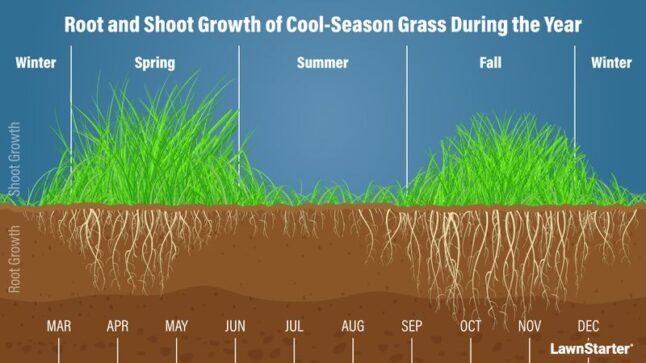
Cool-season grasses should be overseeded in the spring or fall, though fall is usually preferred. These grasses grow in the northern part of the United States. Their most active growth periods are spring and fall, and they don’t usually grow much in summer. Some of the most common cool-season grasses are Kentucky bluegrass, perennial ryegrass, and fescues.
Plant cool-season grass seeds in late summer or early fall, at least 45 days before the first expected frost in your area. When you overseed, the soil temperature (not the air temperature) should be between 50 and 65 degrees. Check soil temperature with a soil thermometer.
Note: If you have a question on how to overseed a lawn in spring vs. overseeding in fall, keep this in mind: It’s possible to overseed cool-season grasses in the spring since they grow actively during that time. However, it’s actually better to do it in the fall because there are fewer weeds around for the new grass to compete with for water and soil nutrients.
When to Overseed Warm-Season Grass
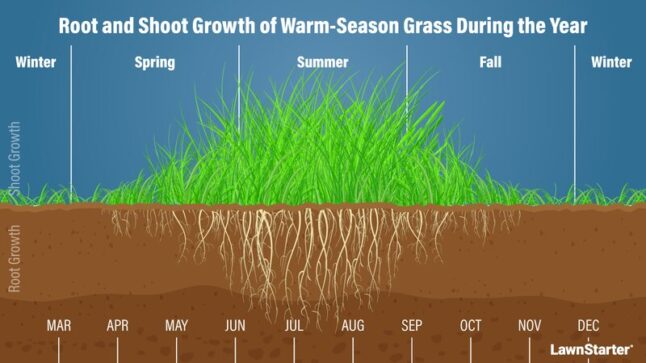
If you’re overseeding your warm-season lawn with warm-season grass seeds, plant them in late spring or early summer when the soil temperature is between 70 and 90 degrees.
Warm-season grasses grow most actively in the heat of late spring and summer, and they thrive in the southern half of the country. Common warm-season grasses include Bermudagrass, Zoysiagrass, centipedegrass, and St. Augustinegrass.
Add Winter Color by Overseeding in Fall
But there’s another option for overseeding warm-season grass. Many homeowners choose to add cool-season ryegrass to their lawns during the fall. Overseeding their lawn will help the grass remain green throughout winter. If you’re planting ryegrass seeds, overseed in the fall, when soil temperatures are between 50 and 65 degrees.
In the extreme South, you should use annual ryegrass for winter color. It will die out in June when the temperatures start to rise.
If you live in a milder climate in the middle of the country, you can plant perennial ryegrass, which will survive, go dormant during summer, and green up again next fall. That way, you don’t have to keep overseeding every fall. Don’t bother planting perennial ryegrass in the extreme South, though — it will die in the same heat as the annual variety.
How Often to Overseed Grass
Some lawns that suffer from drought or disease may thin out frequently and need to be overseeded once a year. But for most lawns, you will only need to overseed every few years. Keep an eye on your lawn, and overseed when it starts looking patchy.
Why You Should Overseed Your Lawn
Overseeding has many substantial benefits for your lawn, with no downsides if you do it correctly. There are many benefits to overseeding:
- Fills in thin and bare patches (or prevents them if you act early enough)
- Makes grass grow thicker
- Makes the lawn hardier and more tolerant of drought, heat, diseases, pests, and other issues
- Helps turfgrass crowd out weeds
- Keeps your lawn green through winter (when you overseed with ryegrass in fall)
Note: It is possible when overseeding your lawn to put down too much seed. Always follow the manufacturer’s recommendations on the amount of seed to spread. Too much seed won’t establish seed to soil contact and will be washed away by the rain or eaten by birds.
FAQ
Can You Overseed Before or After Rain?
It’s best not to overseed a wet lawn. To revive a tired lawn, overseed when the soil is dry and there’s no heavy rain in the forecast for a few days. Heavy rain could wash away the seeds before they have a chance to germinate.
Can You Mix Different Types of Grass Seed?
Yes. Mixing different grasses is actually better than planting only one grass type. You can combine the strengths of different grass types to make your lawn more tolerant of traffic, drought, heat, or shade. You should usually stick to either warm-season grass types or cool-season grass types, except in the case of ryegrass.
For example, here are two common grass seed combinations:
- Kentucky bluegrass and fescue: Fescue is more drought-tolerant, and Kentucky bluegrass spreads to fill bare spots and repair damage. They compensate for each other’s weaknesses.
- Bermudagrass and perennial ryegrass: Bermuda stays green in summer while ryegrass is dormant, and ryegrass stays green in winter while Bermuda is dormant (this mixture is only an option in the transition zone, where both cool-season and warm-season grasses can grow).
Will Grass Seed Grow if I Just Throw It Down?
It might grow, but it won’t be as thick and healthy as you want it to be. For best results, prepare the lawn beforehand as described in the above overseeding steps and add compost and/or fertilizer to the soil.
How Much Does It Cost to Overseed a Lawn?
Hiring a professional lawn care service to overseed your lawn costs about $1,000 on average for materials and labor (although your exact cost depends on where you live and the size of your yard).
If you overseed your lawn, you’ll spend between 1 cent and 15 cents per square foot of lawn for the grass seed itself, depending on the grass type and the seed brand. Remember to factor fertilizer, topsoil, and other necessary supplies into your total DIY cost.
Professional Lawn Care Help
Armed with all the important tips for overseeding lawns, you can now look forward to thicker and healthier grass after the process is complete. However, consistent lawn maintenance, including mowing and fertilizing, is key.
Don’t have time for all that mowing? Don’t sweat it – weekly service from LawnStarter’s local lawn care pros is only a click away.
Sources:
Main Photo Credit: Shutterstock

